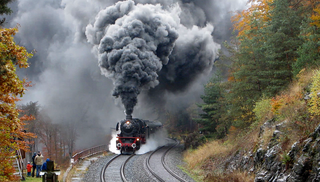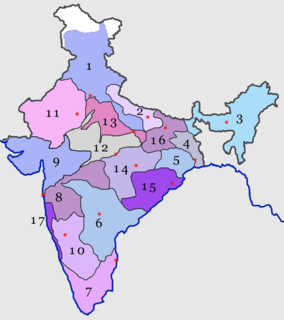Related Research Articles

British Railways (BR), which from 1965 traded as British Rail, was the state-owned company that operated most of the overground rail transport in Great Britain between 1948 and 1997. It was formed from the nationalisation of the "Big Four" British railway companies and lasted until the gradual privatisation of British Rail, in stages between 1994 and 1997. Originally a trading brand of the Railway Executive of the British Transport Commission, it became an independent statutory corporation in 1962 designated as the British Railways Board.

The Canadian Pacific Railway (CPR), also known formerly as CP Rail between 1968 and 1996, and known as simply Canadian Pacific is a historic Canadian Class I railroad incorporated in 1881. The railroad is owned by Canadian Pacific Railway Limited, which began operations as legal owner in a corporate restructuring in 2001.

A narrow-gauge railway is a railway with a track gauge narrower than standard 1,435 mm. Most narrow-gauge railways are between 600 mm and 1,067 mm.

Rail transport is a means of transferring of passengers and goods on wheeled vehicles running on rails, also known as tracks. It is also commonly referred to as train transport. In contrast to road transport, where vehicles run on a prepared flat surface, rail vehicles are directionally guided by the tracks on which they run. Tracks usually consist of steel rails, installed on ties (sleepers) and ballast, on which the rolling stock, usually fitted with metal wheels, moves. Other variations are also possible, such as slab track, where the rails are fastened to a concrete foundation resting on a prepared subsurface.

A standard-gauge railway is a railway with a track gauge of 1,435 mm. The standard gauge is also called Stephenson gauge after George Stephenson, International gauge, UIC gauge, uniform gauge, normal gauge and European gauge in the EU and Russia. It is the most widely used railway track gauge across the world, with approximately 55% of the lines in the world using it. All high-speed rail lines use standard gauge except those in Russia, Finland, Portugal and Uzbekistan. The distance between the inside edges of the rails is defined to be 1435 mm except in the United States, where it is still defined in U.S. customary units as exactly "four feet eight and one half inches".

The Trans-Siberian Railway is a network of railways connecting Moscow with the Russian Far East. With a length of 9,289 kilometres, from Moscow to Vladivostok, it is the longest railway line in the world. There are connecting branch lines into Mongolia, China and North Korea. It has connected Moscow with Vladivostok since 1916, and is still being expanded.

The Great Western Railway (GWR) was a British railway company that linked London with the south-west and west of England, the West Midlands, and most of Wales. It was founded in 1833, received its enabling Act of Parliament on 31 August 1835 and ran its first trains in 1838. It was engineered by Isambard Kingdom Brunel, who chose a broad gauge of 7 ft —later slightly widened to 7 ft 1⁄4 in —but, from 1854, a series of amalgamations saw it also operate 4 ft 8 1⁄2 in standard-gauge trains; the last broad-gauge services were operated in 1892. The GWR was the only company to keep its identity through the Railways Act 1921, which amalgamated it with the remaining independent railways within its territory, and it was finally merged at the end of 1947 when it was nationalised and became the Western Region of British Railways.

A heritage railway is a railway operated as living history to re-create or preserve railway scenes of the past. Heritage railways are often old railway lines preserved in a state depicting a period in the history of rail transport.

A steam locomotive is a type of railway locomotive that produces its pulling power through a steam engine. These locomotives are fueled by burning combustible material – usually coal, wood, or oil – to produce steam in a boiler. The steam moves reciprocating pistons which are mechanically connected to the locomotive's main wheels (drivers). Both fuel and water supplies are carried with the locomotive, either on the locomotive itself or in wagons (tenders) pulled behind.

In rail transport, track gauge or track gage is the spacing of the rails on a railway track and is measured between the inner faces of the load-bearing rails.

Indian Railways (IR) is India's national railway system operated by the Ministry of Railways. It manages the fourth largest railway network in the world by size, with 67,368-kilometre (41,861 mi) route.. Routes are electrified with 25 kV AC electric traction while thirty three percent of them are double or multi-tracked.

The South Central Railway is one of the 18 zones of Indian Railways. The jurisdiction of the zone is spread over the states of Maharashtra, Telangana, and some portions of Madhya Pradesh. It has three divisions under its administration, which include Nanded, Secunderabad, Hyderabad.

Central Railway is one of the 18 zones of Indian Railways. Its headquarters is in Mumbai at Chhatrapati Shivaji Maharaj Terminus. It has the distinction of operating first passenger railway line in India, which opened from Mumbai to Thane on 16 April 1853.

The Western Railway is one of the 18 zones of Indian Railways, and is among the busiest railway networks in India. The major railway routes of Indian Railways which come under Western Railways are: Mumbai Central - Ratlam, Mumbai Central - Ahmedabad and Palanpur - Ahmedabad. The railway system is divided into six operating divisions: Vadodara, Ahmedabad, Rajkot, Bhavnagar, Ratlam, and Mumbai Central. Vadodara railway station, being the junction point for the Ahmedabad - Mumbai route and the Mumbai - Ratlam route towards New Delhi, is the busiest junction Station in Western Railways and one of the busiest junctions of Indian Railways too, while Ahmedabad Division earns highest revenue followed by Mumbai Division and Vadodara Division. Surat railway station is one of the busiest railway station in Western Railway in non-junction category where more than 160 trains pass per day.

Pakistan Railways is the national, state-owned railway company of Pakistan. Founded in 1861 and headquartered in Lahore, it owns 4,800 miles (7,791 km) of track across Pakistan from Torkham to Karachi and operates freight and passenger service. Pakistan Railways was also known as the Pakistan Western Railway from 1947 to 1974.

The Eastern Railway is among the 18 zones of the Indian Railways. Its headquarters is at Fairley Place, Kolkata and comprises four divisions: Howrah, Malda, Sealdah, and Asansol. Each division is headed by a Divisional Railway Manager (DRM). The name of the division denotes the name of the city where the divisional headquarters is located. Eastern Railway Consists Most no. of A1 and A Category Stations like Howrah, Sealdah, Bhagalpur, Asansol, Durgapur etc. Eastern Railways operates one of the oldest trains of India, Kalka Mail. 3 Popular Zones ECR, SER NFR were part of ER before.

The Ministry of Railways is a ministry in the Government of India, responsible for the country's rail transport. The ministry operates the state-owned Indian Railways, an organisation that operates as a monopoly in rail transport and is headed by the Chairman of Railway Board. The ministry is headed by the Minister of Railways, a cabinet-level minister who presents the rail budget every year in parliament.

A train station, railway station, railroad station, or depot is a railway facility or area where trains regularly stop to load or unload passengers or freight. It generally consists of at least one track-side platform and a station building (depot) providing such ancillary services as ticket sales and waiting rooms. If a station is on a single-track line, it often has a passing loop to facilitate traffic movements. The smallest stations are most often referred to as "stops" or, in some parts of the world, as "halts".
References
- ↑ Kiloh, Margaret; Sibeko, Archie (2000). A Fighting Union. Randburg: Ravan Press. p. 2. ISBN 0869755277.
| This legislation article is a stub. You can help Wikipedia by expanding it. |